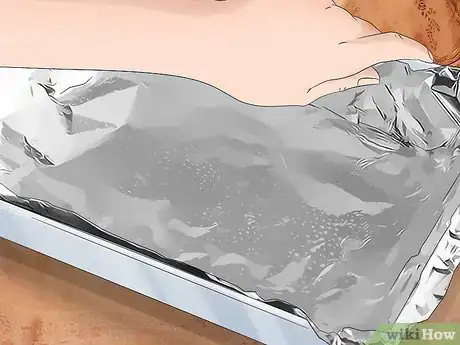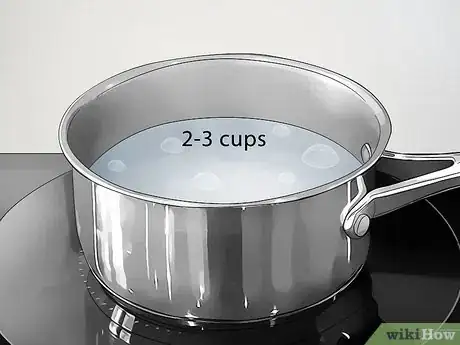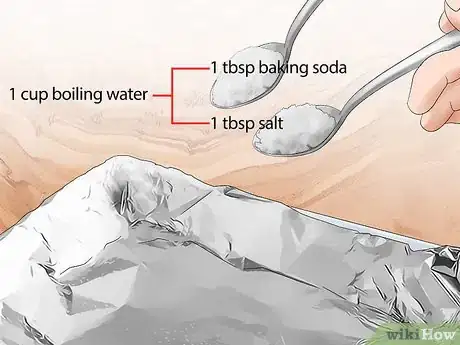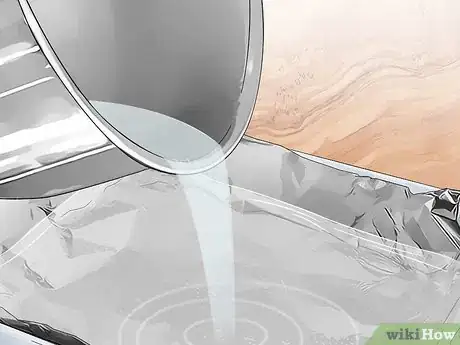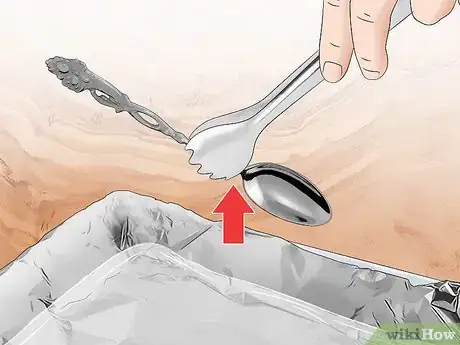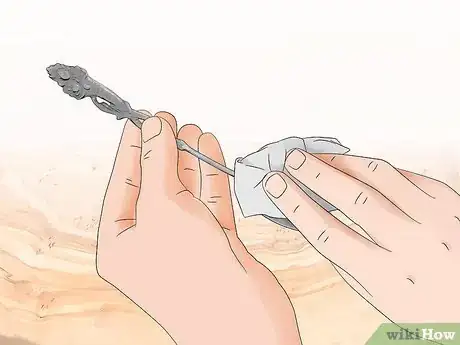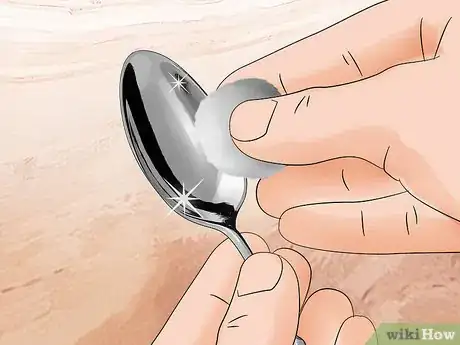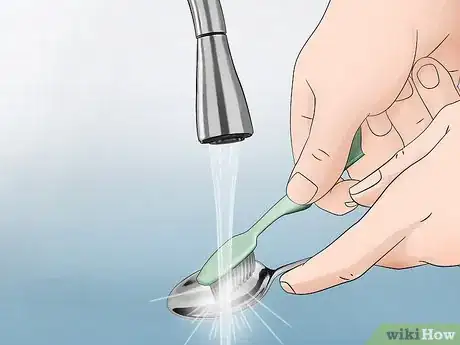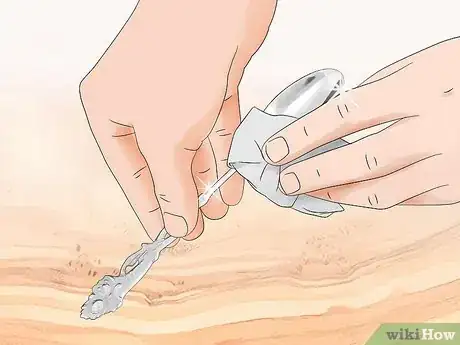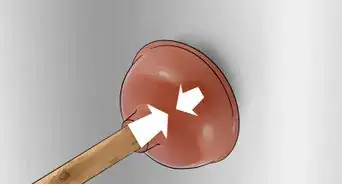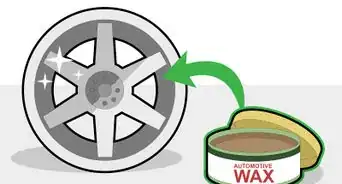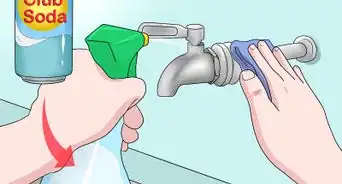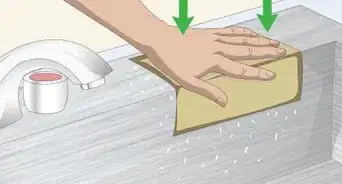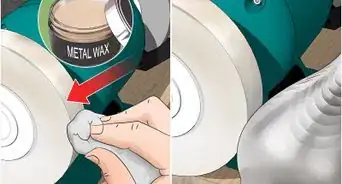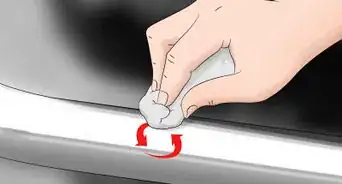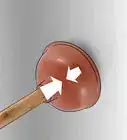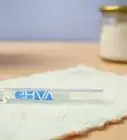This article was co-authored by Jerry Ehrenwald and by wikiHow staff writer, Eric McClure. Jerry Ehrenwald, GG, ASA, is a graduate gemologist in New York City. He is the previous President of the International Gemological Institute and the inventor of U.S.-patented Laserscribe℠, a means of laser inscribing onto a diamond a unique indicia, such as a DIN (Diamond Identification Number). He is a senior member of the American Society of Appraisers (ASA) and is a member of the Twenty-Four Karat Club of the City of New York, a social club limited to 200 of the most accomplished individuals in the jewelry business.
This article has been viewed 21,254 times.
There are a variety of ways to clean tarnished silver. You can mix together a natural cleaning solution using vinegar, salt, and baking soda to submerge your silver. If you want to make things easy, specialized silver sprays, creams, or wipes can be found at your local cleaning supply or antique store and are usually easy to use. If you need to scrub silver pieces with lots of intricate details, use a clean toothbrush and non-whitening toothpaste to clean out hard-to-reach areas.
Steps
Soaking Silver in Baking Soda and Vinegar
-
1Line a glass or plastic pan or bowl with aluminum foil. Pull out a sheet of aluminum foil that is big enough to line the inside of your container. Flatten the foil along the inside of the pan or bowl with the palm of your hand, leaving the shiny side exposed and facing up.[1]
- Choose a glass pan or bowl that is big enough to fully submerge your silver in. Check before you pull out the foil by placing your silver in a potential container. If it is at least 3–4 inches (7.6–10.2 cm) below the surface, it will work.
- This method is not the best for antique or patterned silver, since it removes tarnish uniformly across the entire surface.
-
2Boil water in a large pot. Fill a pot with tap water, turn the heat on high, and wait for it to reach a rolling boil. Use enough water to completely submerge your silver. For cutlery or jewelry, 2–3 cups (0.47–0.71 L) should be plenty, but you may need more water for vases, candlesticks, or larger silver objects.[2]
- You need to know exactly how much water you’re using, so measure it and jot down the amount before you start boiling it. Work in 1-cup increments to make calculating ingredients easier.
- Depending on the amount of water that you’re using, it may take 10-20 minutes for your water to start boiling.
Advertisement -
3Place salt and baking soda at the bottom of your bowl or pan. Add 1 tablespoon (15 mL) of salt and 1 tablespoon (15 mL) of baking soda for every 1 cup (240 mL) of water that you’re boiling. Use measuring spoons or a measuring cup to calculate your baking soda and salt and pour it into the bottom of your foiled pan or bowl.
- Skip the salt if you’re cleaning jewelry. It can erode certain glues used to bind plating or gemstones.
-
4Pour 1⁄2 cup (120 mL) of white vinegar into the bowl for every 1 tablespoon (15 mL) of baking soda. Slowly pour your white vinegar on top of the baking soda. The solution will fizz immediately, so watch out for splashing. Mix the solution with a wooden spoon until all of the salt granules and clumps of baking soda are fully dissolved.[3]
- For example, if you’re using 4 cups (950 mL) of water, then you need 4 tablespoons (59 mL) of baking soda. That means you need to pour 2 cups (470 mL) of vinegar into the bowl or pan.
Warning: If you use any kind of vinegar other than white vinegar, you could stain or damage your silver.
-
5Add your boiling water to the vinegar solution carefully. Use oven mitts to lift your boiling water over your bowl or pan and pour it slowly into you vinegar. Mix it with your wooden spoon to ensure that the entire solution is thoroughly mixed together.[4]
- A slotted spoon is preferable since it will make it easier to mix the solution.
-
6Submerge your silver in the solution for 5-10 minutes. Put on a set of rubber gloves and slowly lower each piece of silver into the solution. Ensure that each piece of silver is fully under the surface of the solution. Wait 5-10 minutes to let the cleaning solution soften and erode the tarnish.[5]
- You can place jewelry in a plastic colander or strainer and submerge that instead if you want to make the removal process easier.
-
7Flip your silver over while it’s in the solution if it has a flat bottom. If your silver is flat and one of the object’s sides is flush with the floor of your pan, use tongs to rotate it while it’s still in the solution after 3-5 minutes. Grip it with your tongs and turn your wrist to flip it over. This way, every side of your silver is equally exposed to the vinegar and baking soda.[6]
-
8Remove your silver with your tongs and place it on a soft cloth. After your silver has soaked for 5-10 minutes, set up a soft cloth flat on your counter or table. Lift each piece of silver out of the pot or pan and lightly shake it over the container to shake off any remaining drops of vinegar and water. Place each piece of silver on your soft cloth and wait 2-3 minutes to let it cool.[7]
- If you used a colander to hold jewelry, hold it over the container and let it drip dry for 15-20 seconds before dumping your jewelry on to the cloth. Spread the jewelry out by hand while you’re wearing rubber gloves.
-
9Buff your silver with a microfiber cloth. Wear rubber gloves to avoid getting oils from your skin on the silver as you buff it. Hold a clean microfiber cloth in your dominant hand and brace your silver with your nondominant hand. Rub every surface of your silver with the microfiber cloth by using firm, circular motions. Continue rubbing tarnished areas until the tarnish is fully removed.[8]
- Never use paper towels to buff your silver—the fibers can actually scratch your silver.
- Let your silver air dry 1-2 hours before using it.
- Store your jewelry in tarnish-proof fabric or a clean fabric lined space that is enclosed and air-tight. This will prevent any contact with moisture or outside air from tarnishing the jewelry.[9]
- Keep your jewelry away from the bathroom or any space that contains a lot of moisture or humidity.[10]
- Be sure to store individual jewelry items separately and away from others so that it won’t corrode from other materials.[11]
Scrubbing with Silver Polish
-
1Purchase a silver polish from a cleaning supply or antique store. You can purchase silver polish in liquid, cream, wipe, or spray form. Creams tend to be better for thicker silvers, while wipes make polishing a surface easy. Sprays make polishing details or intricate jewelry simple. Liquids tend to be designed for dipping or soaking.[12]
- If you aren’t sure which form of polish is best for you, choose a basic silver polishing wipe. The wipes are typically the easiest to work with.
Tip: Some silver polishes are designed for jewelry or antique items. Select a specialty polish if you’re cleaning sensitive or expensive silver.
-
2Rinse your silver under cold water and wipe it dry. Before applying your silver polish, you need to remove any preexisting debris or dust. To do this, run your silver under a steady stream of cold water in your sink. Rub each surface area lightly by hand and then dry it with a soft, clean cloth.[13]
- Don’t use any soap or cleaner while you’re rinsing your silver. You don’t want soap residue to mix with the silver polish.
-
3Apply your silver polish based on your brand’s specific instructions. Some creams need to be massaged into the silver, while some liquid polishes require the silver to be dipped or submerged entirely. Most wipes require you to scrub tarnished areas in soft, circular motions. Follow your specific polish’s instructions by reading the label carefully.[14]
- Sprays typically require you to liberally coat the silver with the spray before rubbing it in.
- You usually need to let the polish settle in the silver for a few minutes after applying it.
-
4Wipe your polish off with a clean cloth, sponge, or cotton ball. If your instructions don’t indicate how you should dry your silver off, use a flannel or microfiber cloth to wipe your polish by carefully rubbing it over each portion of your silver’s surface. If you’re using a liquid polish, rinse it under cold water before wiping it dry. Some creams don’t require wiping after they’ve been applied.[15]
- Store your silver in a cool, dry area after you’ve polished it.
Brushing Silver with Toothpaste
-
1Select a toothpaste that lists baking soda as an ingredient. Read a potential toothpaste’s list of ingredients to see if it contains baking soda. Toothpaste is an excellent choice for silver with a lot of intricate details because the toothbrush can dig into hard-to-reach engravings and areas. Any toothpaste that lists baking soda as a main ingredient will work to clean tarnish off of a silver.[16]
- Avoid any toothpaste with a whitening agent. These ingredients usually contain abrasive chemicals that can damage your silver.
-
2Place your silver on top of a dry cloth or towel and wet your toothbrush. Set your silver over a clean towel, rag, or cloth to give it a cushion if it falls over during scrubbing. Fill your toothbrush with your toothpaste and run it under cool water for 1-2 seconds to lubricate it.[17]
- Use a brand-new toothbrush to do this.
Tip: You don’t have to run the brush under cold water, but it will make it a little easier to scrub the toothpaste into your silver.
-
3Brace your silver with your nondominant hand and scrub it. Place your nondominant hand on the side opposite of the area that you want to brush. Hold your toothbrush firmly and place the toothpaste directly against the tarnished surface and scrub using back-and-forth strokes. Scrub each tarnished area until you can see the residue lifting off of the silver.[18]
- Reload your toothbrush as needed whenever the toothpaste seems to be fully rubbed into your silver.
- It may require multiple applications of toothpaste to get tarnish out of details with particularly intricate engravings.
-
4Rinse your silver under cold water and continue scrubbing. Hold your silver under a sink while the water is running cold and continue to scrub with your toothbrush. Scrub each section that you cleaned with toothpaste to remove any residue.[19]
- If you notice that there is still some tarnish on an area and it isn’t coming off under the stream of water, re-scrub it with toothpaste before rinsing it again.
-
5Dry your silver with a clean cloth and buff it. Once you’ve re-scrubbed every section, place your silver on a dry cloth or towel. Give it a quick wipe to remove most of the water and then buff it with a microfiber cloth. Rub your silver in soft, circular motions until it is completely dry and clear of tarnish.[20]
Things You’ll Need
Soaking Silver in Baking Soda and Vinegar
- Aluminum foil
- Baking soda
- White vinegar
- Salt
- Measuring cup or spoons
- Pot
- Glass bowl or pan
- Tongs
- Soft cloth
- Microfiber cloth
Scrubbing with Silver Polish
- Silver polish
- Cold water
- Sink
- Dry cloth
Brushing Silver with Toothpaste
- Toothpaste
- Toothbrush
- Sink
- Cold water
- Dry cloth
- Microfiber cloth
References
- ↑ https://www.consumerreports.org/cleaning/best-cleaning-supplies-for-the-job/
- ↑ https://www.consumerreports.org/cleaning/best-cleaning-supplies-for-the-job/
- ↑ https://www.today.com/home/how-clean-silver-here-s-what-you-need-know-t99946
- ↑ https://www.today.com/home/how-clean-silver-here-s-what-you-need-know-t99946
- ↑ https://www.theguardian.com/lifeandstyle/2016/jun/07/how-to-polish-silver-the-green-way
- ↑ https://www.today.com/home/how-clean-silver-here-s-what-you-need-know-t99946
- ↑ https://www.today.com/home/how-clean-silver-here-s-what-you-need-know-t99946
- ↑ https://www.today.com/home/how-clean-silver-here-s-what-you-need-know-t99946
- ↑ Jerry Ehrenwald. Former President, International Gemological Institute & Graduate Gemologist. Expert Interview. 12 August 2019.
- ↑ Jerry Ehrenwald. Former President, International Gemological Institute & Graduate Gemologist. Expert Interview. 12 August 2019.
- ↑ Jerry Ehrenwald. Former President, International Gemological Institute & Graduate Gemologist. Expert Interview. 12 August 2019.
- ↑ https://eng.mst.dk/media/mst/69098/16.pdf
- ↑ https://eng.mst.dk/media/mst/69098/16.pdf
- ↑ https://www.bobvila.com/articles/how-to-polish-silver/
- ↑ https://www.bobvila.com/articles/how-to-polish-silver/
- ↑ https://www.bobvila.com/articles/how-to-polish-silver/
- ↑ https://www.bobvila.com/articles/how-to-polish-silver/
- ↑ https://www.bobvila.com/articles/how-to-polish-silver/
- ↑ https://www.bobvila.com/articles/how-to-polish-silver/
- ↑ https://www.bobvila.com/articles/how-to-polish-silver/
